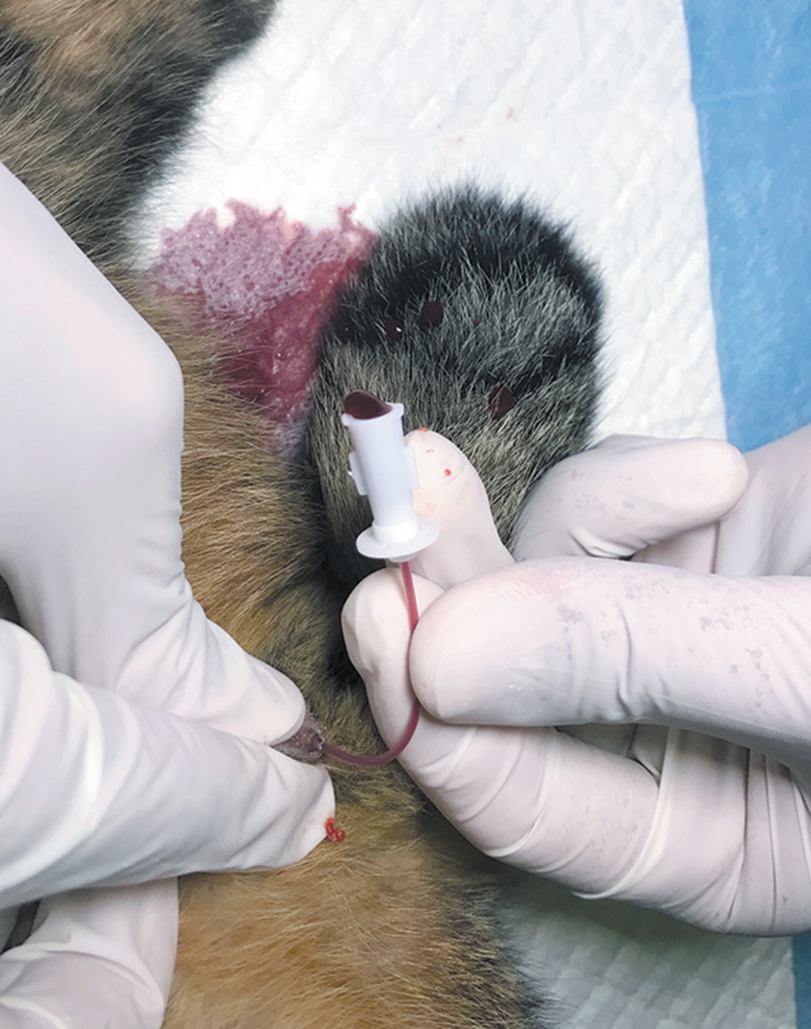A straining cat and a dry litterbox are reasons for concern. Straining is most commonly associated with urinary problems. You may notice your cat urinating—or attempting to urinate—in odd places like the sink, bathtub, or a dark corner. This may be because your cat is associating the pain of trying to urinate with the litterbox.
Urethral Blockage
Cats are prone to urinary problems, ranging from mild inflammation to urethral blockage. Unfortunately, many of the initial signs can be deceptive until your cat is critically ill.
Any cat prone to cystitis (bladder inflammation) or crystal formation in his urine could eventually have a urethral blockage. Cystitis is more common in males, as their urethra has a smaller diameter and is longer than the urethra of female cats.
Urethral blockages are an emergency. Retained urine can lead to your cat resorbing many of the toxins and metabolites that should be eliminated in urine. Left untreated, they can be fatal.
Risk factors include being male and time of year, with winter months being of particular concern. While the reason for this seasonal assocation is not clear, decreased water consumption and decreased activity have been proposed as potential factors.
Indoor cats, especially if they are not active or are overweight, have a higher risk of blockage. Stress, from living in a multi cat household, moving, or dealing with aggression from another cat, may contribute as well. Consuming a primarily dry diet while not drinking enough water is a risk factor.
You Should Know
Symptoms of Urinary Problems
- Blood in urine
- Frequent urinating
- Licking genital area
- Absent or decreased amounts of urine
- Spending longer times in litter box, especially with little result
- Urinating out of litter box
- Pain with urination
- Straining to urinate
Types of Blockages
Two types of urinary tract blockages are the most common in cats. First is a “cellular plug,” which is a compacted clump that may include protein, mucus, cells, cellular debris, and crystals. Cats with urethral plugs often suffer from feline idiopathic cystitis, which is likely the most common urinary problem, especially in cats under 10 years of age. Idiopathic, of course, means “of unknown cause.” It’s frustrating for owners and veterinarians.
The second-most common blockage is uroliths (stones) or an accumulation of urinary crystals that block the orifice. Rarely, cats can have urethral spasms in response to pain or inflammation that shut down the urethra.
Struvite (composed of nitrogen, phosphorus, and magnesium) is the most common component of crystals and stones in blocked cats. Dietary changes can help to dissolve bladder stones of struvite and prevent recurrence of crystal buildups of this mineral complex. This often involves using a prescription diet.
Diagnosis
Diagnosis of urinary blockage is usually made via the clinical history of straining in the litterbox with little or no urine produced and a large urinary bladder identified during physical examination. This examination is performed very gently to avoid rupturing the bladder. If the bladder has already ruptured and your cat has free urine in the abdomen, the prognosis is poor.
While a blood chemistry panel is not needed for diagnosis, it can provide valuable information. Cats that have been blocked for very long will often have high levels of potassium in the blood (hyperkalemia). Hyperkalemia can predispose to life-threatening cardiac arrhythmias and neurologic problems.
Initial Treatment
When a blocked cat is presented at the veterinary clinic, one of the first things done is to relieve the distended bladder. This is often done by cystocentesis, a procedure that involves draining the bladder via a needle that is passed through the abdominal wall. For cats that are less ill, catheter placement may be the first step. Any urine obtained should be microscopically evaluated (urinalysis), and cultures of the urine should be obtained. Meanwhile, intravenous fluids are often started to help flush away toxins and encourage kidney function. Calcium gluconate, dextrose, sodium bicarbonate, and/or insulin may be administered to help reduce the potassium levels, depending upon how elevated they are.
The next step is to unblock the urethra. Sedation is almost always required to place a urinary catheter. Rarely, some cats relax enough under sedation that a cellular plug can be massaged out of the end of the urethra to allow free urine flow. Placing a urinary catheter requires patience and a gentle hand. Any crystalline blockage will usually be pushed back into the bladder.
Atracurium besylate is an antispasmodic medication that can temporarily paralyze the muscle lining the urethra, and flushing this into the urethra may facilitate the removal of any urethral plugs.
Once in place, the catheter is used to drain any urine left in the bladder and then the bladder is flushed to remove any small crystals and cellular debris. Depending on the individual case, the catheter may be sewn in place for between 24 to 72 hours. The average time for a urinary catheter to remain in place for a cat with urethral obstruction is 48 hours. For mild cases, it may be removed after the bladder is thoroughly flushed. Spasmolytic drugs, urethral relaxants, or anti-inflammatories may be given to settle irritated tissues.
Cats with recurrent blockages or that have suffered for a prolonged period with a greatly distended bladder may suffer from a bladder rupture or from urinary nerve and muscle damage that can prevent the ability to urinate normally. A bladder rupture requires emergency surgery. Bladder nerve and muscle damage may resolve with time and medications, but the prognosis is usually poor once this type of damage has occurred.
Recent studies show that cats have less chance of a recurrence within 30 days if a catheter is left in until there is normal urine flow, both in amount and appearance. You want to have all blood clots, small crystals, and cellular debris flushed out. While urethral irritation is a consideration with a catheter left in, this can be managed with medications.
It is important to have your cat in the hospital and under veterinary observation until potassium levels have normalized. While most cases of urinary obstruction do not have bacterial infections, your veterinarian may decide to culture a catheter that has been left in for a couple of days to rule out any secondary infections. Cats should show normal urine production and flow before being released from the veterinary clinic.
Follow-Up
Once your cat is stabilized, with the bladder emptied and flushed and potassium levels normalized, your veterinarian may recommend some more diagnostics to clarify the cause of the blockage. Radiographs and/or ultrasound will show any bladder or kidney stones. A dye study may be used to look for any ruptures in the bladder or urethral walls.
Alternatively, cystoscopy (passage of a small flexible camera into the urethra) allows direct evaluation of the urethra and bladder walls. This might be combined with a shock wave or laser fiber to break up stones in the bladder or urethra (called lithotripsy). This is more commonly done in dogs, but it can be done in cats.
Follow-up blood work to check potassium levels and kidney function, and electrocardiograms (EKGs) to monitor cardiac health are important.

Olga Chetvergova | iStock
Surgical Treatment
Unfortunately, some cats will suffer from a recurrence of urinary blockages. These cats may benefit from a surgery called a perineal urethrostomy (PU). “We usually recommend a PU on the second offense. If dietary and environmental management were given a good try and were found to be ineffective, especially if it is within six months of the first episode, then we recommend PU surgery,” says James Flanders DVM DACVS Emeritus Associate Professor, Section of Small Animal Surgery at Cornell University’s College of Veterinary Medicine.
A PU surgery may sound drastic, but many cats thrive after having the surgery. The goal is to provide a permanent opening wide enough that crystals, mucus plugs, cellular debris clumps, or small stones can pass out of the urethra. It does not change the underlying cause of the problem but allows the cat to have a “work around” solution.
Much of the penis is removed during a PU surgery in male cats since the penile urethra is quite small. “The urethral lumen is only 1 millimeter (mm) in diameter in the male cat penis. It is 4 mm wide in the pelvic urethra. So, it is very important that the stoma (opening) be made using the pelvic urethra,” says Dr. Flanders. The pelvic urethra is pulled backward (toward your cat’s tail), incised, and sutured to the skin under the tail. Many people think of it as turning your male cat into a female, at least urethra-wise.
Aftercare is extremely important. Your cat may need a catheter in place as the tissues heal and he will need to wear a cone to prevent him from licking at the surgical site or chewing out his sutures. If possible, surgeons try to use dissolvable suture material, but some cases will need suture removal. Once the surgery site is healed, most cats do fine.
Dr. Flanders has found the most common surgical complication is stricture, usually due to inadequate dissection and not finding the pelvic urethra. “There really aren’t many other common complications. Some people are concerned about an increased risk of urinary tract infections because the urethra has been shortened. This is very rarely a problem because the good urine stream is able to keep the urethra free of contamination.”
Minimizing Risk
Cat owners would prefer to prevent an episode of urinary obstruction completely and avoid a recurrence if possible. There are things you can do to help your cat avoid urinary problems:
Consider switching your cat to canned food if he eats dry food. Some cats may need a prescription urinary diet. Other cats will tolerate water being added to their normal diet.
Encourage drinking. Make fresh water always available. Provide multiple options with a minimum of one bowl per cat. If your cat prefers a fountain, make sure you have one available. Adding a few drops of tuna juice to a bowl can encourage drinking.
Make sure you have an adequate number of litterboxes, in easily accessible sites. Clean daily.
Practice stress management, if needed. Use pheromones like Feliway, limit your cat numbers to a small compatible group, and try to establish a set routine for the household.
Watch your cat’s weight to avoid obesity. Encourage activity and provide enrichment in the environment plus play time with you.
Fit and Trim
Does neutering of male cats increase risk of urinary blockage? The experts say no. Neutered male cats may be at more risk, however, if they are overweight and inactive house cats. Being fit and trim reduces the risk for many health problems.




